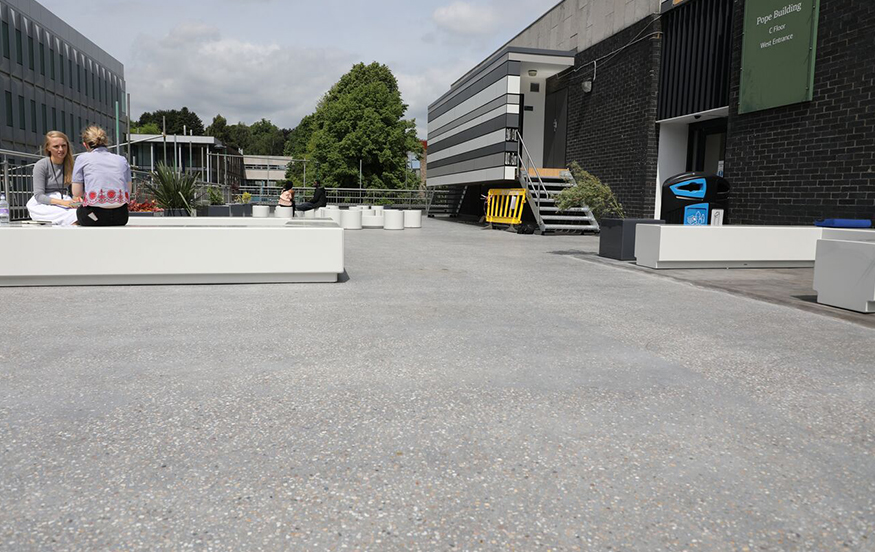Mastic asphalt is considered as one of the most traditional waterproofing materials available, having provided protection from water penetration for centuries. For some, it is perceived as an old fashioned material, but like many long-lasting materials that have stood the test of time, it is being re-imagined and modified in a modern way. Detailed below are top tips and key considerations for roofing contractors and specifiers to bear in mind when using mastic asphalt.
Speed and Ease of Application
For major projects, mastic asphalt is usually taken to site by hot charge transporters or insulated dumpers direct from the manufacturer and taken to the point where it is needed for rapid installation – a major advantage for contracts with critical time constraints. For smaller projects, solid blocks are preheated in boilers placed at ground level.
Mastic asphalt can be laid very swiftly. One 18 tonne hot charge delivery vehicle can supply sufficient mastic asphalt to cover 360m2of material to a depth of 20mm, which can be laid and finished in a matter of hours. This makes it particularly suitable for larger roofs where it can be applied over in-situ or precast concrete, timber or metal decking. Roofs can be quickly and efficiently waterproofed allowing other trades on site, often within hours. The flowing characteristics of mastic asphalt make it easy for installing contractors to tackle roof surfaces which are complex, stepped or with multiple protrusions.
Flame-Free Application
Contractors are increasingly asked to utilise flame-free roofing systems, eliminating any fire risk from naked flame so that buildings can remain open and fully operational during roof refurbishment work if required. This is particularly important for work carried out in schools, hospitals and health facilities, as there is minimal disruption to the school term or normal routines. As mastic asphalt is laid in molten form, it is often confused with other types of waterproofing membrane that require naked flame or torch on application. In reality, there is no naked flame at the point of installation and because mastic asphalt is so highly flame resistant, there is little or no potential of fire risk.
The high mineral content of mastic asphalt renders it virtually incombustible. Mastic asphalt fulfils all the external fire resistance required for a roof covering and achieves the highest rating (AA) when tested in accordance with BS 476: Part 3. It has also been tested in accordance with draft European standards prEN1187-1 and prEN1187-2. No significant spread of flame was observed and no flame penetration occurred.
Green Credentials and Sustainability
Mastic asphalt is well known for being tough, durable and long-lasting, but what is perhaps less well known is that it is one of the most sustainable and greenest building materials currently available, helping specifiers to achieve the highest BREEAM rating possible as mastic asphalt can be integral in any building design where an A+ rating is required.
More and more contractors and specifiers are choosing mastic asphalt for a wide range of green roof applications – from schools to hospitals, office buildings to apartment blocks. Whether intensive or extensive, biodiverse or brown, it is critical that green roofs are built on a solid waterproofing foundation. Recognised for its environmental performance and aesthetic properties, a green roof system laid with a mastic asphalt waterproofing system enhances the environment, controls storm water run-off and reduces noise and heat transmissions by upgrading the acoustic and thermal performance of a roof. When contractors use mastic asphalt for a green roof system, it eliminates the need for root barriers, which may well have been necessary had a substitute material been used.
Mastic asphalt has one further advantage over other types of waterproof membrane – it is carbon neutral – a massive bonus for any building owner anxious to show their green credentials and, when it has reached the end of its useful life, it can be recycled or used as roof screed, minimising the impact on the environment. Ten years ago the mastic asphalt sector became the first industry in the world to achieve the CarbonZero standard.
Quality of Workmanship
Mastic asphalt is one of the few construction activities still regarded as a ‘craft trade’. The skilled work involves ensuring that asphalt is at the correct temperature, and then spreading it using traditional techniques to coat the surface. A thermoplastic material that changes shape when heated, mastic asphalt cures to form a hard, durable, finished product to suit all applications of mastic asphalt. To maintain the industry’s reputation and ensure high quality applications for every single project, only trained applicators are permitted to install mastic asphalt under the Mastic Asphalt Council’s strict rules.
Being a MAC member enhances the reputation of a contractor and gives a badge of quality and assurance that they meet very highest of standards with regards to factors such as trading and credit history, insurance policies and quality of workmanship.
Durability
The Building Research Establishment (BRE) has officially stated that asphalt roofing is capable of lasting 50-60 years, but the Mastic Asphalt Council (MAC) has many examples well in excess of this. For instance, mastic asphalt was first laid at London’s St Paul’s Cathedral in 1906 and it provided well over 100 years’ of effective waterproofing before it needed replacement. Even though the roofing sector is highly competitive, it’s unlikely that there are any other roofing systems that can boast a comparable lifespan.
Cost-Effective
Mastic asphalt offers lower installation costs than many other types of membrane and it outperforms other systems when it comes to life cycle costs. Increasingly, specifiers are not just looking at installation costs, they are considering life cycle costs and the life cycle cost of mastic asphalt is much lower than competitive roofing systems. In the unlikely event of a failure, mastic asphalt’s seamless structure means it can easily be spot repaired, eliminating the need for costly wholesale replacement.
Heritage Applications
The heritage market is a key sector for the industry and mastic asphalt is frequently specified by the National Trust and English Heritage, as well as other public and private owners of prestigious buildings for refurbishment projects. Buckingham Palace is testament to the longevity of mastic asphalt. On top of the Royal household is a rooftop of mastic asphalt that has kept the building dry for well over 80 years. Other heritage applications include the Houses of Parliament, the Tower of London, Tower Bridge and Edinburgh Castle. Although mastic asphalt is a traditional material that was first patented in 1837 and has been around for years in more simple guises than today, it offers durability and wear resistance far beyond modern alternatives.
Protective
A roof is on the front-line every day, so it pays to specify a waterproofing material which can withstand whatever Mother Nature throws at it – whether it is wind, snow, rain, frost or strong sunlight. Wind gives roofs a beating, especially taller structures or those buildings which have more exposed roofing surfaces. Vibration caused by wind can lead to material fatigue and crack formation. Hail and snow can also cause mechanical roof damage, whilst freeze/thaw cycles are a frequent source of breakdown for many roofing materials. Water expands when it freezes and can therefore enlarge cracks. Mastic asphalt is one of the toughest waterproofing membrane systems currently available and it can be rapidly applied in testing weather conditions.
Aesthetic
There is an increasing need amongst specifiers to use roofing materials which not only offer effective waterproofing, durability and longevity, but an aesthetic element. This is particularly the case if roofing substrates are visible such as balconies, walkways and deck areas.
The Mastic Asphalt Council has seen a trend emerging amongst MAC members of the use of mastic asphalt terrazzo in external applications. Terrazzo is traditionally perceived as an internal wall or floor finish, but the incorporation of mastic asphalt makes it ideally suited for roofing and other external applications. The long and rich history of terrazzo, with archaeologists discovering terrazzo in ancient Neolithic settlements as far back as 8000 years ago, is testament to its status as a construction material that stands the test of time.
Today, modern interpretations of terrazzo have been created by combining decorative stone chippings with mastic asphalt, which is then polished to create infinite possibilities in any design situation. Some perceive mastic asphalt terrazzo as having a distinctly ‘retro’ look and no two installations are ever the same, as the aggregate is exposed as part of the finishing process. Other finishes can also be created – such as matt or smooth – as opposed to the highly polished effect normally associated with terrazzo. Different visual effects can be created depending on the size and type of aggregate added at the mixing point to create a bespoke finish. Mastic asphalt terrazzo offers the durability and distinctive features of terrazzo and consists of a traditional mastic asphalt base with a modern finish. Slip and skid resistance can be incorporated into the wearing course of the mastic asphalt.
Versatility
One of the distinct advantages of mastic asphalt is its versatility. In recent years, there has been an influx of projects where mastic asphalt screeds have been used to provide a stable and cost-effective base for waterproofing applications – from green roofs to car park decks.
Unlike traditional cement screeds which can be slow to cure and labour intensive, there are mastic asphalt screeds on the market that cure rapidly even in inclement weather conditions and can be walked on within just 60 minutes, making them ideal for fast-track projects where other trades are waiting to get to work and the screed needs to trafficked or overlaid quickly. Mastic asphalt screeds have zero water content, eliminating the time taken for moisture to evaporate in traditional screeds and eradicating the risk of cement stained water penetrating into the underlying structure.
The flexibility and fast curing times of mastic asphalt screeds enable roofing contractors to achieve precise drainage falls quickly and more efficiently, level out uneven substrates and provide a stable base for a specified roofing deck system. Laid at a minimum thickness of 10mm, the screed thickness is up to 80% less than traditional materials, making it much lighter and equally suited for both refurbishment and new build projects.
Able to be applied to in-situ and precast concrete, timber and plywood, mastic asphalt screeds are suitable for use below cold roofs, insulated warm roofs, inverted insulated roofs, green roofs, balcony and terrace applications, walkways, footbridges and both car park and HGV service decks. For full waterproofing protection, mastic asphalt screeds can be overcoated with mastic asphalt roofing systems, as well as other roofing systems such as felt, hot melt roofing, liquid coatings and single ply roofing.
This article featured in the online May edition of RCi magazine – click here to take a look.

